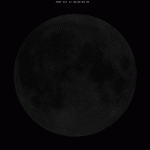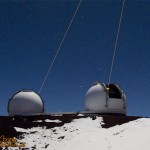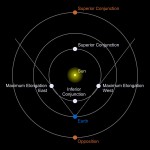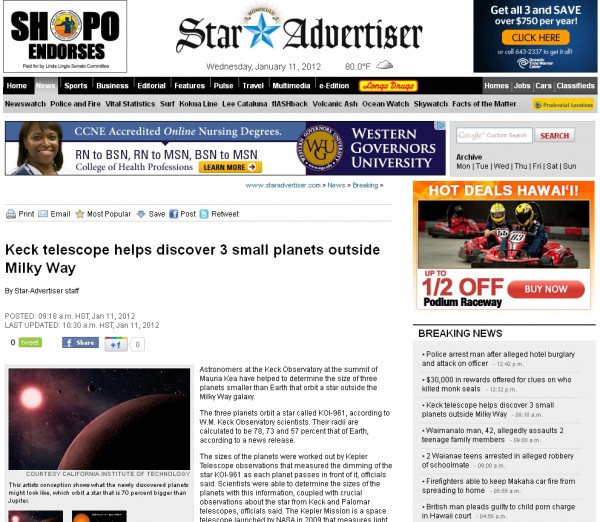
Tell congress to kill the SOPA & PIPA legislation
Author: Andrew
Postcard from the Reef – Leaf Scorpionfish
Dave spotted it, what appeared as a piece of debris lying in the coral. A closer look showed this ‘debris’ has fins. It is a Leaf Scorpionfish crouching low in the coral. I have seen a few members of this interesting family lately, often challenging to spot.

Lunar Apogee and Perigee
Does the Moon seem a little larger and brighter than usual? It may not be an illusion, sometimes the Moon really does look a little larger or smaller in the sky.
Like all orbiting objects, the Moon does not orbit in a perfect circle, but rather in an ellipse. This means that as it orbits it is a little further away or a little closer. In the case of the Moon the difference is not much, but you can see it, if you know to look.


The period of time between full Moons, the synodic month, is about 29.5 days. While lunar perigee occurs every 27.5 days, an anomalistic month. Since these periods are not equal, the cycle drifts in and out of phase. About once a year the cycles coincide and full Moon and apogee or perigee will occur near the same time.
At apogee, the Moon will be appear about 29 arc-minutes in size, a little less than half a degree. At perigee the Moon will be about 33 arc-minutes across, a bit more than half a degree. The numbers may not seem like much, but it is a visible difference. The simulated images shown here will give a better idea of what the numbers represent.
This change in size and distance leads to the moonlight being a bit brighter at perigee than at apogee, about a 30% difference. So if that moonlit night seems brighter than you remember it may actually be the case.
Saturnine Storm

This picture, captured on Feb. 25, 2011, was taken about 12 weeks after the storm began, and the clouds by this time had formed a tail that wrapped around the planet. Some of the clouds moved south and got caught up in a current that flows to the east (to the right) relative to the storm head. This tail, which appears as slightly blue clouds south and west (left) of the storm head, can be seen encountering the storm head in this view.
Laser Return Photometery
A different use for amateur astrophotography gear.
An amateur CCD camera can do more than take pretty pictures. There is no reason why any decent telescope, however small, and a CCD camera can not be used to do real science, or real engineering in this case.
The goal of the night was to perform proper photometry on the laser returns with independent equipment. We want to quantify the performance of the Keck adaptive optics laser systems. We launch two powerful lasers into the sky, one from each telescope, to allow analysis of the atmospheric distortions through which the telescope is observing. Using the data the system can correct for this atmospheric distortion and create much sharper images of distant stars and galaxies.
The lasers pass through a layer of sodium atoms about 90km (55miles) above the ground. There the 589nm yellow light excites these sodium atoms creating a glowing beacon, what we call the laser return. This return is what we look at to analyze atmospheric distortion. A brighter return allows better data and better performance of the system.

Both the Keck 1 and Keck 2 lasers in operation under the light of a nearly full Moon
Amateur astrophotography gear is perfectly capable of doing this task. A portable telescope, a proper CCD camera, combined with care to acquire calibrated images. All that I needed to add to the setup was a photometric V filter.
It was a perfect night for it, clear, dry and cold. Best of all, there was no wind to bounce the telescope around and chill anyone working outside. The winds are nearly constant atop at 14,000ft peak, calm nights are unusual, I was lucky indeed.
I setup the telescope atop a crust of ice and snow. The snow was convenient as it allowed me to set down gear on a cleaner surface than the gritty volcanic cinder underneath, keeping everything quite a bit cleaner. The altitude and cold made setup and breakdown a slow, laborious process, and added unique difficulties. I had to be very careful moving the heavy gear, so as not to slip on the icy snow. When I went to move the telescope tripod I found it frozen into the snow and cinder! I had to heave hard to break it free.
Small Solar System Found
For years the search for exoplanets has largely been like Gulliver’s visit to Brobdingnag: colossal systems of giant gas planets orbiting mammoth stars. But astronomers have finally landed on the shores of Lilliput. They have found a tiny star with three puny planets, each smaller than Earth, zooming around it.
The three small exoplanets orbit a star called KOI-961. Their radii are calculated to be 78, 73 and 57 percent that of Earth. The sizes of the planets were worked out by Kepler Telescope observations that measured the dimming of the star KOI-961 as each planet passes in front of it. This plus crucial information about the star from Keck and Palomar telescopes enabled researchers to determine the sizes of the planets.
Although the masses of the three planets are unknown, they are suspected of being rocky, like Earth, Venus, Mars and Mercury. But they orbit too close to their star to be in the habitable zone where liquid water could exist. The three planets take less than two days to orbit around KOI-961, which is a red dwarf with a diameter one-sixth that of our sun, making it just 70 percent bigger than Jupiter.
“This is the tiniest solar system found so far,” said John Johnson, the principal investigator of the research from NASA’s Exoplanet Science Institute at the California Institute of Technology in Pasadena. “It’s actually more similar to Jupiter and its moons in scale than any other planetary system. The discovery is further proof of the diversity of planetary systems in our galaxy.”
Magnitude
Throughout the astronomical descriptions and event posts here on Darker View I use the term magnitude to describe the brightness of an object in the sky. Magnitude is a simple scale, but somewhat confusing without a quick introduction.
The origins of our current magnitude scale are as old as the science of astronomy itself. One of the first stellar catalogs, the Almagest, was compiled by Claudius Ptolemy in the 2nd century. To denote the brightness of stars the catalog assigned the brightest as being “stars of the first rank”, with a corresponding second rand, third rank, etc. The dimmest of stars, the faintest visible to the unaided eye, were assigned to the sixth rank. This system was used with little alteration for the next two millennium. Subsequent catalogs and observers used their own versions of the scale, perhaps adding a decimal place to denote finer differences in brightness. As there was no instrumental method of measuring the brightness, magnitude estimates varied widely from source to source.
With the dawn of modern photographic methods and later electronic methods, it became possible to systematize the scale. It was desirable to create a scale that approximated the old system and time honored traditions. Thus the current magnitude scale was developed, understanding the origins allows understanding of the modern system.
Employment at Keck – Electronics Engineer
W. M. Keck Observatory position announcement…
The W.M. Keck Observatory seeks an Electronics Engineer to join a multi-disciplinary engineering team that operates, maintains, and improves high-technology systems at the observatory including telescope controls, primary mirror controls, adaptive optics and more. This is a challenging fast-paced technical environment where teamwork, and interpersonal communication are essential skills.
The observatory operates two of the largest and most scientifically productive optical/infrared telescopes in the world. The twin 10-meter telescopes are located amidst several other world class observatories on the summit of Mauna Kea, at 13,796 feet above sea level on the Big Island of Hawaii, one of the premier sites for astronomy. The successful candidate will have the opportunity to join a skilled and deeply committed team of technical professionals who enable exciting and important astronomical discoveries.
Qualifications for this position include a Bachelor of Science degree in Engineering with emphasis in electronics and control systems and five years of work experience designing, building, analyzing, testing and troubleshooting of electronics and electromechanical systems. The ideal candidate will have a strong understanding of analog and digital electronics, real-time PID motion control systems, computer interfaces, noise, shielding and grounding principles, and be well organized and have good documentation skills. Desirable skills include project planning and management, configuration management, and knowledge of electronics and electrical engineering standards. Because of the observatory’s location, a significant amount of time will be spent working at high altitude.
This position requires you to submit your resume on-line at: http://keckobservatory.iapplicants.com/ViewJob-262125.html with your cover letter that states why you are uniquely qualified for the position.
Additional information about WMKO and this position may be found on our website at www.keckobservatory.org EEO/M/F/D/V
Elongations, Conjunctions and Oppositions
As a planet moves across the sky there are particular points in its orbit that describe the motion, part of the jargon of astronomy that can confuse the uninitiated. These terms do not represent anything difficult, you just have to visualize what they mean. Understanding the movements of planets across the sky gives a little insight into our beautiful universe.

Superior Conjunction, Inferior Conjunction, Opposition and Maximum Elongation tell any experienced skywatcher exactly where a planet is with respect to the Earth, where it is in our sky, and where it will be in the coming weeks or months. It is all part of the intricate patterns of our solar system that allow anyone who learns to become familiar with the night sky.
Continue reading “Elongations, Conjunctions and Oppositions”
Science Illiteracy at the Star-Advertiser
We do like it when Keck Observatory is featured in the local papers. We are proud of the ‘scopes and take notice when we get some good press. The Star-Advertiser is the major daily paper for Honolulu and much of the state. I have even had some of my photographs published in the paper. Another article about Keck appeared today, but this time they simply display their ignorance of basic science.
Keck telescope helps discover 3 small planets outside Milky Way
The headline quickly had my attention. Exoplanet discoveries are coming fast with the Kepler Spacecraft / Keck Observatory team confirming alien worlds at a breakneck pace. It was the “outside the Milky Way” part that had my attention. I had no idea our current technology was capable of that! KOI-961 is a red-dwarf, a small, fairly dim class of star. It is difficult to even detect these stars at great distances, much less get the data needed to confirm orbiting planets. Something wrong here.
I double checked other sources… KOI-961 is actually fairly close to us in galactic terms, a mere 130 light years away. Given that the Milky Way Galaxy is well over 100,000 light years across, it puts KOI-961 well inside our galaxy. The article is actually reasonable, it appears to have simply taken the information from a press release, hard to screw up a cut and paste job. The headline however is where they stumbled hard.
Someone at the Star-Advertiser needs to take a basic astronomy course. Or maybe, simply check Wikipedia!
Update… They have fixed it. I forwarded the link to Larry O’Hanlon, the Keck PIO, whom I work with regularly. He called the S-A and apparently pointed out the issue. I would have loved to listen in on that conversation. The headline and text are edited now on the S-A website, but I kept a screenshot…

